Centauri Dreams
Imagining and Planning Interstellar Exploration
A Resonant Sub-Neptune Harvest at HD 110067
The ancient notion of the ‘music of the spheres’ sounds primitive until you learn something about planetary dynamics. Gravity is wondrous and can nudge planets in a given system into orbits that show an obvious mathematical ratio. Two planets in resonance can emerge, for instance, in a 2:1 ratio, where one goes around its star twice in the time it takes the second to orbit it once. Such linkages might seem almost coincidental to the casual observer until the coincidences begin to pile up.
In the exoplanet system at HD 110067, for example, resonance flourishes, so much so that we have six planets moving in a ‘resonance chain.’ No coincidence here, just gravity at work, although an actual coincidence is that just when I finished a post highlighting system dynamics in closely packed environments like TRAPPIST-1 as a ‘brake’ on inbound comets, an international team should reveal HD 110067’s resonance chain. It’s a beauty, for all six planets not only move in harmonic rhythm but also turn out to be transiting worlds. An orbital dance this complex is rare, but even more so is the ability to study such worlds thanks to the happenstance of our viewing angle.
Transits allow us to extract information, and plenty of it, including analysis of planetary atmospheres as light from the central star passes through them. Because complex resonances are in some sense ‘self-correcting,’ they tell us something about the history of the system, for planet migration during the period when the resonance is being established influences the final state of the system. In HD 110067 we have a mother lode of system harmonics around a star that, usefully enough, is fifty times brighter than TRAPPIST-1, where we have seven rocky planets in a resonant chain.
HD 110067 offers up all of this for that highly interesting category of planets called ‘sub-Neptunes,’ about which we’d like to know a lot more. 100 light years away in the constellation Coma Berenices, HD 110067’s resonance chain is obviously complex. The innermost planet makes three orbital revolutions as the second world makes two – a 3:2 resonance. But the chain continues: 3:2, 3:2, 3:2, 4:3, and 4:3, with the innermost planet making six orbits as the outermost planet completes one.
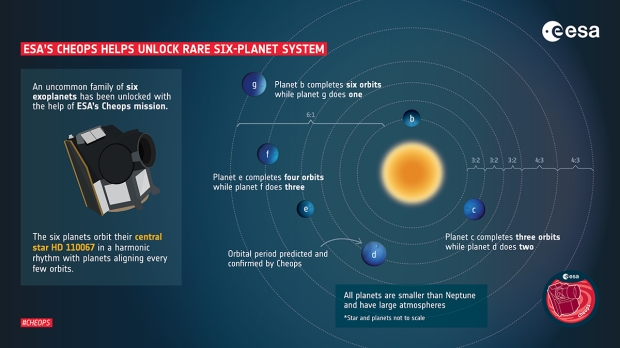
Image: A rare family of six exoplanets has been unlocked with the help of ESA’s Cheops mission. The planets in this family are all smaller than Neptune and revolve around their star HD110067 in a very precise waltz. When the closest planet to the star makes three full revolutions around it, the second one makes exactly two during the same time. This is called a 3:2 resonance. The six planets form a resonant chain in pairs of 3:2, 3:2, 3:2, 4:3, and 4:3, resulting in the closest planet completing six orbits while the outermost planet does one. CHEOPS confirmed the orbital period of the third planet in the system, which was the key to unlocking the rhythm of the entire system. This is the second planetary system in orbital resonance that CHEOPS has helped reveal. The first one is called TOI-178. Credit and copyright: ESA.
Untangling this particular chain was not easy. The astronomers used data from both ESA’s CHEOPS mission and the TESS space observatory to nail down the system architecture. Data from TESS determined the orbital periods of the innermost worlds to be 9 and 14 days. Observations from CHEOPS tagged planet d at 20.5 days and thus demonstrated that while the innermost planet revolves 9 times around the star, the second revolves six, and the third planet four times. The periods of the three outer planets could then be deduced as 31, 41 and 55 days respectively, with further analysis of the TESS data showing that no solution other than the 3:2, 3:2, 3:2, 4:3, 4:3 chain would work. Ground-based observations supplemented the TESS and CHEOPS data.
The analysis was led by Rafael Luque (University of Chicago) and published in Nature. Says Luque:
“This discovery is going to become a benchmark system to study how sub-Neptunes, the most common type of planets outside of the solar system, form, evolve, what are they made of, and if they possess the right conditions to support the existence of liquid water in their surfaces.”
TOI-178 offers a five-planet resonance chain that may include a sixth world in this system of transiting planets in the constellation Sculptor, some 200 light years out. The paper on HD 110067 takes note of the fact that resonant architectures like these imply a situation that has remained unchanged since the birth of the system, making them useful laboratories for planet formation and evolution. The planetary radii at HD 110067 range from 1.94 that of Earth to 2.85 times as large (1.94R⊕ to 2.85R⊕), and the low densities found in the three planets whose mass has been measured point to the likelihood of large atmospheres dominated by hydrogen.
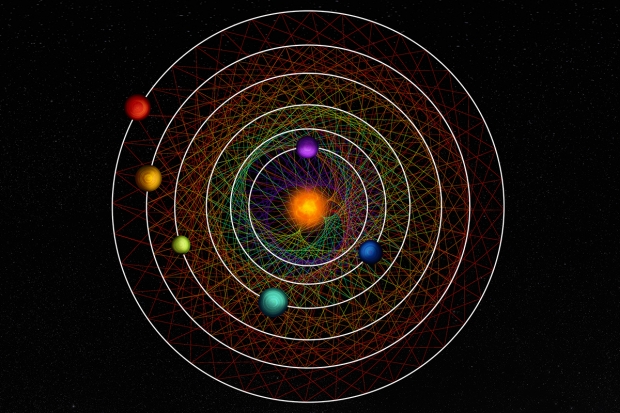
Image: Tracing a link between two neighbor planets at regular time intervals along their orbits creates a pattern unique to each couple. The six planets of the HD110067 system create together a mesmerizing geometric pattern due to their resonance-chain. © CC BY-NC-SA 4.0, Thibaut Roger/NCCR PlanetS.
Ann Egger (a graduate student at the University of Bern and a co-author of the paper on this work) notes what is ahead in the study of this system:
“The sub-Neptune planets of the HD110067 system appear to have low masses, suggesting they may be gas- or water-rich. Future observations, for example with the James Webb Space Telescope (JWST), of these planetary atmospheres could determine whether the planets have rocky or water-rich interior structures.”
The sheer beauty of the HD 110067 system comes across in the animation below:
Image: To-scale animation of the orbits of the six resonant planets in the HD110067 system. The pitch of the notes played when each planet transits matches the resonant change in orbital frequencies between each subsequent planet. The relative sizes of the planets is accurate, although their true size compared to the star is much smaller. Also available at https://www.youtube.com/watch?v=2rrODAG7nmI.
The paper is Luque et al., “A resonant sextuplet of sub-Neptunes transiting the bright star HD 110067,” Nature 623 (November 29, 2023), 932-937 (abstract).

Cometary Impacts: Looking for Life in the Right Places
If you had to choose, which planetary system would you gauge most likely to house a life-bearing planet: Proxima Centauri or TRAPPIST-1? The question is a bit loaded given that there are seven TRAPPIST-1 planets, hence a much higher chance for success there than in a system that (so far) has produced evidence for only two worlds. But there are other factors having to do with the delivery of prebiotic materials by comet, which is the subject of a new paper from Richard Anslow (Cambridge Institute of Astronomy). “It’s possible that the molecules that led to life on Earth came from comets,’’ Anslow reminds us, “so the same could be true for planets elsewhere in the galaxy.”
So let’s untangle this a bit. We don’t know whether comets are vital to the origin of life on Earth or any other world, and Anslow (working with Cambridge colleagues Amy Bonsor and Paul B. Rimmer) does not argue that they are. What their paper does is to examine the environments most likely to be affected by cometary delivery of organics, which in turn could be useful as we begin to study exo-atmospheres for biosignatures. If we can narrow the kind of systems where cometary delivery is likely, that could explain future findings of life signs as opposed to systems without such mechanisms, ultimately supporting the comet delivery model.
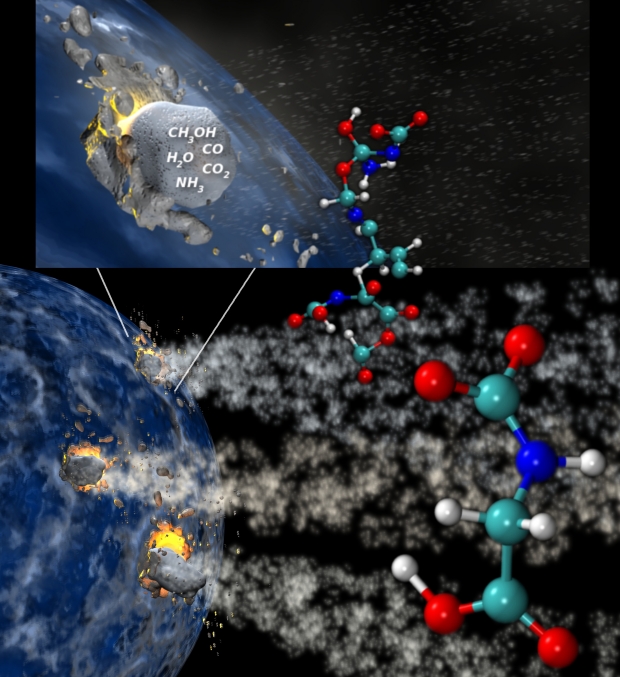
Image: Comets contain elements such as water, ammonia, methanol and carbon dioxide that could have supplied the raw materials that upon impact on early Earth would have yielded an abundant supply of energy to produce amino acids and jump start life. Credit: Lawrence Livermore National Laboratories.
The idea of delivering life-promoting materials by impacts is hardly new. We’ve learned from asteroid return samples like those from Ryugu and now Bennu that the inventory of prebiotic molecules is rich. We’ve also found intact amino acids in meteorite samples, showing the survival of these materials from their entry into the atmosphere. The authors point out that comets contain what they call ‘prebiotic feedstock molecules’ like hydrogen cyanide (HCN) along with basic amino acids, and some studies suggest that by way of comparison with asteroids, comets have delivered two orders of magnitude more organic materials than meteorites because of their high carbon content. But survival is the key, and that involves impact velocity upon arrival.
HCN is particularly useful to consider because its strong carbon-nitrogen bonds may make it more likely to survive the high temperatures of atmospheric entry. What Anslow and team call the ‘warm comet pond’ scenario demands a relatively soft landing. This is interesting, so let me quote the paper on it. A ‘soft landing’:
…excavates the impact point and forms a dirty pond from the cometary components. Climatic variations are thought to cause the episodic drying of these ponds, promoting the rapid polymerisation of constituent prebiotic molecules. It is thought this wet-dry cycling will effectively drive the required biogeochemical reactions crucial for RNA production on the early-Earth, and therefore play an important role in the initial emergence of life… Relatively high concentrations of prebiotic molecules are required for there to be sufficient polymerisation, and so this scenario still requires low-velocity impacts. Specific prebiotic molecules are more (or less) susceptible to thermal decomposition by virtue of their molecular structure, and so the inventory of molecules that can be effectively delivered to a planet is very sensitive to impact velocity.
The question that emerges, once we’ve examined the delivery of molecules like HCN, is what kind of stellar system is most likely to benefit from a cometary delivery mechanism? To address this, the authors construct an idealized planetary system with planets of equal mass that are equally spaced to study the minimum impact velocity that can emerge on the innermost habitable planet. They then use N-body simulations to model the necessary interactions between comets and planets in terms of their position and velocity through time. The snowline marks the boundary between rocky and volatile-rich materials in the disk, as below:

Image: This is Figure 1 from the paper. Caption: Schematic diagram of the idealised planetary system considered in this work with equally spaced planets (brown circles, semi-major axis ai ) scattering comets (small dark blue circles) from the snow-line. The blue region represents the volatile-rich region of the disc where comets occur, and the green region represents the habitable zone. Low velocity cometary impacts onto habitable planets will follow the lower arrows, which sketch the dynamically cold scattering between adjacent planets. The dynamically hot scattering as shown by the upper arrows, will result in high velocity impacts.
That equal spacing of planets is interesting. The authors call it a ‘peas in a pod’ system and note what other astronomers have observed, that “…individual exoplanet systems have much smaller dispersion in mass, radius, and orbital period in comparison to the system-to-system variation of the exoplanet population as a whole.” And indeed, tightly packed systems with equal and low-mass planets have been shown to be highly efficient at scattering comets into the inner system and hence into the habitable zone. Giant outer planets, it’s worth noting, may form in these tight systems, their effects helping to scatter comets inward, but they are not assumed in the author’s model.
The impactor’s size and velocity tell the tale. What we’d like to see is a minimum impact velocity below 15 kilometers per second to ensure the survival of the interesting prebiotic molecules like HCN. The simulations show that the impact velocity around stars like the Sun is reduced for lower mass planets, the effect being enhanced if there are planets in nearby orbits. Impact velocities drop even more for planets around low mass stars in tightly-packed systems (here again, think TRAPPIST-1), for here the comets tend to be delivered on low eccentricity orbits, a significant factor because impact speeds around low-mass stars are typically high. From the paper:
…the results of our N-body simulations demonstrate that the overall velocity distribution of impactors onto habitable planets is very sensitive to both the stellar-mass and planetary architecture, with the fraction of low-velocity impacts increasing significantly for planets around Solar-mass stars, and in tightly-packed systems. It will be these populations of exoplanets where cometary delivery of prebiotic molecules is most likely to be successful, with significant implications for the resulting prebiotic inventories due to the exponential decrease in survivability with impact velocity.
We learn from all this that we have to be attuned to the mass of the host star and the nature of planetary distribution there to be able to predict whether or not comets can effectively deliver prebiotic materials to worlds in the habitable zone. If this seems purely theoretical, consider that telescope time on future missions to study exoplanet atmospheres will be a precious commodity, and these factors may emerge as an important filter for observation. But we’ll also find out whether the correlations the authors have uncovered re lower mass, tightly packed planets are demonstrated in the presence of the biosignatures we are looking for. That may tell us whether comets are a significant factor for life’s emergence on distant worlds as well as our own.
The paper is Anslow, Bonsor & Rimmer. “Can comets deliver prebiotic molecules to rocky exoplanets?” Proceedings of the Royal Society A (2023). Full text. Thanks to my friend Antonio Tavani for the pointer to this work.

Tightening Proxima Centauri’s Orbit (and an Intriguing Speculation)
Although I think most astronomers have assumed Proxima Centauri was bound to the central binary at Alpha Centauri, the case wasn’t definitively made until fairly recently. Here we turn to Pierre Kervella (Observatoire de Paris), Frédéric Thévenin (Côte d’Azur Observatory) and Christophe Lovis (Observatoire Astronomique de l’Université de Genève). We last saw Dr. Kervella with reference to a paper on aerographite as a sail material, but his work has appeared frequently in these pages, analyzing mission trajectories and studying the Alpha Centauri system. Here he and his colleagues use HARPS spectrographic data to demonstrate that we have at Centauri a single gravitationally bound triple system. This is important stuff; let me quote the paper on this work to explain why (italics mine):
Although statistical considerations are usually invoked to justify that Proxima is probably in a bound state, solid proof from dynamical arguments using astrometric and radial velocity (RV) measurements have never been obtained at a sufficient statistical significance level. As discussed by Worth & Sigurdsson (2016), if Proxima is indeed bound, its presence may have impacted planet formation around the main binary system.

This is a six-year old paper, but I want to return to it now because a new paper from the same team will tighten up its conclusions and slightly alter some of them. We’ve gone from resolving whether Proxima is bound to the A/B binary to pondering the issues involved in the dynamical history of this complex system. That in turn can inform the ongoing search for planets around Centauri A and B at least in terms of explaining what we might find there and how these two systems evolved. The original paper on this work lays out the challenges involved in tracing the orbit of the red dwarf. For HARPS is exquisitely sensitive to the Doppler shifts of starlight, and these data, obtained between 2004 and 2016, contain potential booby traps for analysis.
Image: Pierre Kervella, of the Observatoire de Paris/PSL.
Convective blueshift is one of these. We’re looking at the star’s spectral lines as we calculate its motion, and some of these are displaced toward the blue end of the spectrum because of the structure of its surface convection patterns. The lifting and sinking of hot internal gases has to be factored into the analysis and its effect nulled out. The spectral lines are displaced toward the blue, in effect a negative radial velocity shift, although the effect is stronger for hotter stars. In the case of Proxima, Kervella’s team finds a relatively small convective blueshift, though still one to be accounted for.
A similar though more significant issue is gravitational redshift, which occurs as photons climb out of the star’s gravity well. Here the effect is “an important source of uncertainty on the RV of Proxima” whose value can be established and corrected. How the astronomers went about making these corrections is laid out in a discussion of radial velocities that aspiring exoplanet hunters will want to read.
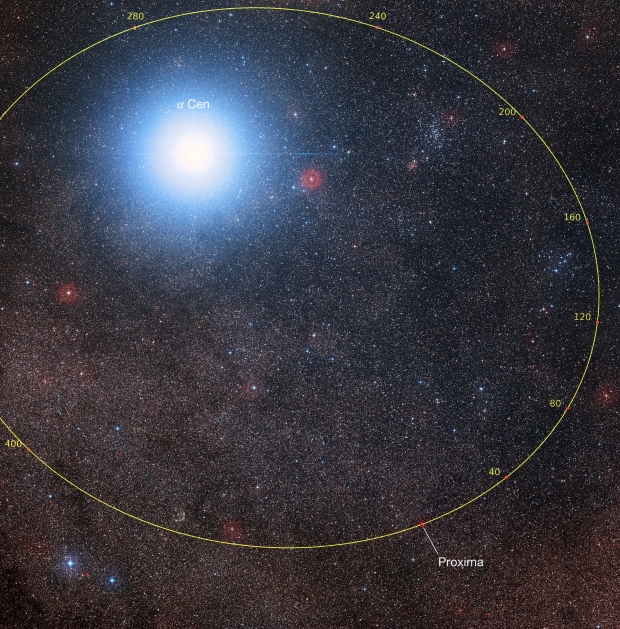
Image: Orbital plot of Proxima showing its position with respect to Alpha Centauri over the coming millenia (graduations in thousands of years). The large number of background stars is due to the fact that Proxima is located very close to the plane of the Milky Way. Credit: P. Kervella/ESO/Digitized Sky Survey 2/Davide De Martin/Mahdi Zamani.
Out of all this we learn that Proxima’s elliptical orbit around Centauri A and B’s barycenter extends from 800 billion kilometers when closest (periastron) to 1.9 trillion kilometers at apastron, its farthest distance, with an orbital period of approximately 550,000 years. The orbital phase is currently closest to apastron.
The Astronomy & Astrophysics site (this is the journal in which the paper above appeared) is currently down, so I’m quoting from the version of the paper on arXiv, which after noting that the escape velocity of Alpha Centauri at Proxima’s distance (545 +/- 11 m/s) is about twice as large as Proxima’s measured velocity, goes on to speculate in an intriguing way:
Proxima could have played a role in the formation and evolution of its planet (Anglada-Escudé et al. 2016). Conversely, it may also have influenced circumbinary planet formation around αCen (Worth & Sigurdsson 2016). A speculative scenario is that Proxima b formed as a distant circumbinary planet of the αCen pair, and was subsequently captured by Proxima. Proxima b could then be an ocean planet resulting from the meltdown of an icy body (Brugger et al. 2016). This would also mean that Proxima b may not have been located in the habitable zone (Ribas et al. 2016) for as long as the age of the αCen system (5 to 7 Ga; Miglio & Montalbán 2005; Eggenberger et al. 2004; Kervella et al. 2003; Thévenin et al. 2002).
The idea of Proxima b as a captured planet has not to my knowledge appeared anywhere else in the literature. I was fascinated, enough so that I dashed off a quick email to Dr. Kervella asking about this as well as the current status of the orbital calculations. And indeed, his response indicates new work in progress:
… we identified a mistake in our 2017 determination of the orbital parameters of Proxima. In the papier, they are expressed in the Galactic coordinate system, and the orbital inclination is thus not directly comparable to that of the Alpha Cen AB orbit. We are preparing a new publication with revised orbits and parameters for all three stars. The main difference is that now the orbital plane of Proxima is better aligned with that of AB. The gravitationally bound nature of Proxima with Alpha Cen AB is also strengthened, as we include new astrometry and radial velocities.
I’ll cover the new paper as soon as it appears. Dr. Kervella also observes that confirming a scenario of Proxima b as a captured planet would be difficult (Proxima b has ‘forgotten’ the history of its orbital evolution, as he puts it), meaning that working with astrometric data alone will not be sufficient. But the arrival of telescopes like the Extremely Large Telescope, now under construction in Chile’s Atacama Desert with first light planned for 2028, should signal a treasure trove of new information. A spectrum obtained by ELT could show us whether Proxima b is indeed an ocean planet.
The paper on Proxima Centauri’s orbit is Kervella, Thévenin & Lovis, “Proxima’s orbit around α Centauri,” Astronomy & Astrophysics Vol. 598 (February 2017), L7 (abstract/preprint).

The Odds on Alpha Centauri
How extraordinary that the nearest star to Earth is actually a triple system, the tight central binary visually merged as one bright object, the third star lost in the background field but still a relatively close 13000 or so AU from the others. Humans couldn’t have a better inducement to achieve interstellar flight on the grounds of these stars alone. We get three stellar types: The G-class Centauri A, the K-class Centauri B, both of which are capable of hosting planets, perhaps habitable, of their own.
And then we have Proxima Centauri, opening up M-class red dwarf stars to close investigation, and we already know of a planet in the habitable zone there, adding to the zest of the venture. If extraterrestrial beings in a system like this would have even more inducement to travel, with another star’s planets perhaps as close to them as our own system’s worlds are to us, we humans are also spurred to undertake a journey, because 4.2 light years is a mere stone’s throw in the overall galactic distribution.
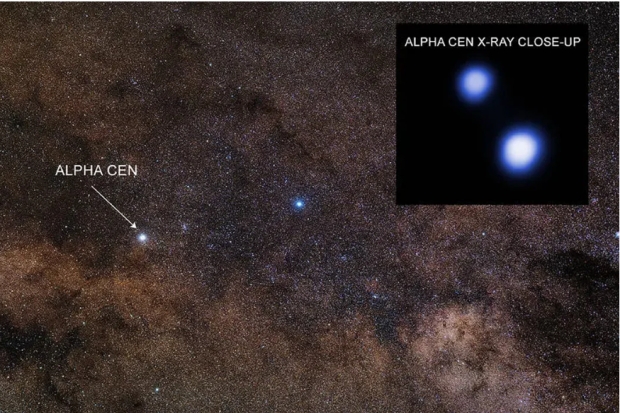
Image: The central binary at Alpha Centauri, with the two stars only resolved in the x-ray image. Credit: X-ray: NASA/CXC/University of Colorado/T.Ayres; Optical: Zdenek Bardon/ESO.
I like this image, used by Dirk Schulze-Makuch to illustrate a recent popular science article, because it includes the Chandra X-Ray imagery. That’s how we can separate the central stars, which are at times nearly as close as Saturn is to the Sun while they orbit their common barycenter. Centauri Dreams readers will recognize Schulze-Makuch (Technical University Berlin and an adjunct professor at Washington State) not only as a prolific writer but the author of a host of scientific papers including many we’ve looked at in these pages. He’s played a valuable role in presenting astrobiological matters to the general public, part of the flowering of interstellar investigation that continues as we keep finding interesting worlds to explore.
If you’re wondering about Proxima Centauri’s location, the image below flags it. Credit: ESO/B. Tafreshi (twanight.org)/Digitized Sky Survey 2; Acknowledgement: Davide De Martin/Mahdi Zamani).
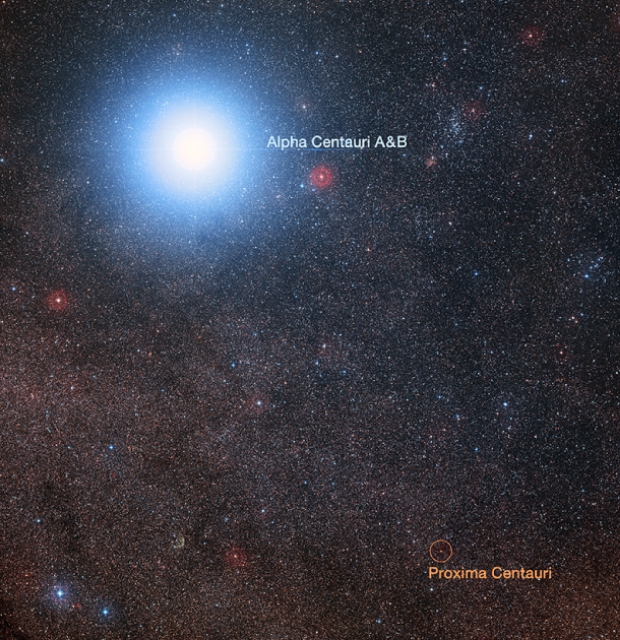
I like to keep an eye on what appears in the popular press from respected scientists, because they’re bringing credibility to matters that often get distorted by mainstream media attention (not to mention what happens on social media sites). We should always give a nod to scientists willing to explain their work and the broader issues involved given that kind of competition for the public’s attention. It’s interesting in this case to get Schulze-Makuch’s take on habitability at Alpha Centauri. He’s pessimistic about Proxima but is surprisingly bullish on Centauri A and B:
The other two stars in the system are believed to have planets, although they have not been confirmed. (A possible Neptune-size planet was reported in 2021 orbiting Alpha Centauri A at roughly the same distance as Earth orbits the Sun, but this could turn out to be a dust cloud instead.) The apparent lack of any brown dwarfs or gas giants close to Alpha Centauri A and B make the likelihood of terrestrial planets greater than it would be otherwise, at least in theory. The chances of a rocky, potentially habitable planet in our neighboring solar system might therefore be as high as 75 percent.
The Proxima Centauri problem is, of course, the X-ray flux, although Schulze-Makuch also considers tidal lock a distinct negative. The Chandra data (citation below) revealed a relatively benign influx of X-rays for Centauri A and B, making them fine hosts for life if it can develop there. But Proxima is deeply problematic, receiving an average dose of X-rays some 500 times greater than Earth’s, and some 50,000 times as great during periods of flare activity, which M-dwarfs are particularly prone to in their younger days.
Here the word ‘younger’ is a bit deceptive. Recall that this kind of star can live for several trillion years. That’s a bit humbling, considering that the universe itself is thought to be 13.8 billion years old. In that sense all M-dwarfs are ‘young.’
Just as we can zoom in via X-ray to see the central stars, we can also take a look at Proxima Centauri’s movements via spectroscopic data, which we’ll examine next time, along with a fascinating speculation on the origin of Proxima b.
For more on the X-ray environment at Alpha Centauri, see Ayres, “Alpha Centauri Beyond the Crossroads,” Research Notes of the AAS Vol. 2, No. 1 (January, 2018), 17 (abstract). The possibility of a ‘warm Neptune’ at Alpha Centauri is discussed in Wagner et al., “Imaging low-mass planets within the habitable zone of α Centauri,” Nature Communications 12, Article number: 922 (2021). Full text. We’ll be talking about this one a bit more in coming days.

Is Interstellar Flight Inevitable?
The wish that humans will one day walk on exoplanets is a natural one. After all, the history of exploration is our model. We look at the gradual spread of humanity, its treks and voyages of discovery, and seamlessly apply the model to a future spacefaring civilization. Science fiction has historically made the assumption through countless tales of exploration. This is the Captain Cook model, in which a crew embarks on a journey into unknown regions, finds new lands and cultures, and returns with samples to stock museums and tales of valor and curiosity.
Captain Cook didn’t have a generation ship, but HMS Endeavour was capable of voyages lasting years, stocking itself along the way and often within reach of useful ports of call. A scant 250 years later, however, we need to consider evolutionary trends and ask ourselves whether our ‘anthropocene’ era will itself be short-lived. Even as we ask whether human biology is up for voyages of interstellar magnitude, we should also question what happens when evolution is applied to the artificial intelligence growing in our labs. This is Martin Rees territory, the UK’s Astronomer Royal having discussed machine intelligence in books like his recent The End of Astronauts (Belknap Press, 2022) and in a continuing campaign of articles and talks.
I won’t comment further on The End of Astronauts because I haven’t read it yet, but its subtitle – Why Robots Are the Future of Exploration – makes clear where Rees and co-author Donald Goldsmith are heading. The title is a haunting one, reminding me of J.G. Ballard’s story “The Dead Astronaut,” a tale in which the Florida launch facilities that propelled the astronaut skyward are now overgrown and abandoned, and the astronaut’s widow awaits the automated return of her long-dead husband. It was an almost surreal experience to read this in the Apollo-infused world of 1971, when it first ran:
Cape Kennedy has gone now, its gantries rising from the deserted dunes. Sand has come in across the Banana River, filling the creeks and turning the old space complex into a wilderness of swamps and broken concrete. In the summer, hunters build their blinds in the wrecked staff cars; but by early November, when Judith and I arrived, the entire area was abandoned. Beyond Cocoa Beach, where I stopped the car, the ruined motels were half hidden in the sawgrass. The launching towers rose into the evening air like the rusting ciphers of some forgotten algebra of the sky.
“[T]he rusting ciphers of some forgotten algebra of the sky.” Can this guy write or what?
You’ll find no spoilers here (Ballard’s The Complete Short Stories is the easiest place to find it these days) but suffice it to say that not everything is as it seems and the scenario plays out in ways that explore human psychology coming to grips with a frontier of deeply uncertain implications. As uncertain, perhaps, as the implications Ballard did not explore here, the growth of artificial intelligence with its own evolutionary path. For that, we can investigate the work of Stanislaw Lem, in particular The Invincible (1964). N. Katherine Hayles wrote a fine foreword to the novel in 2020. Non-human, indeed non-biological evolutionary paths are at the heart of the work.

The scenario should intrigue anyone interested in interstellar exploration. Assume for a moment that a starship carrying both biological beings and what we can call artilects – AI enabled beings, or automata – once landed on a distant planet, where the biological crew died. The surviving artilects cope with the local life forms and evolve gradually toward smaller and smaller beings that operate through swarm intelligence. The driver is the need to function with ever smaller sources of power (the artilects operate via solar power and hence need less as their size decreases), creating an evolutionary pressure that results in intelligent ‘mites.’
A long time later, another crew, the humans of the starship Invincible, has arrived and must cope with the result. As long ago as 1964, before the first Gemini mission had flown, the prescient Lem was saying that swarm intelligence was a viable path, something that later research continues to confirm. As Hayles points out in her foreword, it takes only a few rules to produce complex behaviors in swarming creatures like fish, birds and bees, with each creature essentially in synch with only the few creatures immediately around it. Simple behaviors (in computer terms, only a few lines of code) lead to complex results. Let me quote Hayles on this:
Decades before these ideas became disseminated within the scientific community, Lem intuited that different environmental constraints might lead to radically different evolutionary results in automata compared to biological life forms. Although on Earth the most intelligent species (i.e., humans) has tended to fare the best, their superior intelligence comes with considerable costs: a long period of maturation; a lot of resources invested in each individual; socialization patterns that emphasize pair bonding and community support; and a premium on individual achievement. But these are not cosmic universals, and different planetary histories might result in the triumph of very different kinds of qualities.
In this environment, a visiting starship crew must confront an essential difference in values between the two types of being. Humans bring assumptions drawn out of our experience as a species, including the value of the individual life as opposed to the collective. Remember, we are some years off from Star Trek’s Borg, so once again Lem is pushing the envelope of more conventional science fiction. Hayles will point out that shorn of our anthropocentrism, we may find ourselves encountering forms of artificial life whose behavior can only be traduced by profoundly unsettling experience. A world of collective ‘mites’ may overwhelm all our values.
Given all this, we have to ask whether several more centuries of AI will produce artilects we are comfortable with. The question of control seems almost moot, as what Martin Rees refers to as ‘inorganic intelligence’ quickly moves past our own mental functioning if left to its own devices. We are in the realm of what today’s technologists call ‘strong AI,’ where the artificial intelligence is genuinely alive in its own right, as opposed to being a kind of simulacrum emulating programmed life. A strong AI outcome places us in a unique relationship with our own creations.
The result is a richer and stranger evolutionary path than even Darwin could have dreamed up. We don’t have to limit ourselves to swarms, of course, but I think we can join Rees in saying that creatures evolving out of current AI will probably be well beyond our ability to understand. In a recent essay for BBC Future, Rees quoted Darwin on the entire question of intentionality: “A dog might as well speculate on the mind of [Isaac] Newton.” Not even my smartest and most beloved Border Collie could have done that. At least I don’t think she could, although she frequently surprised me.
A side-note: I would be interested in suggestions for science fiction stories dealing with swarm concepts — as opposed to basic robotics — in the early years of science fiction. Were authors exploring this before Lem?
Rees is always entertaining as well as provocative. He takes an all but Olympian view of the cosmos that draws on his lifetime of scientific speculation, and writes a supple, direct prose that is without self-regard. I’ve only met him once and at that only briefly, but it’s clear that this is just who he is. In a way, what I might consider his detachment from the nonsensical frenzy of too much tenured academic science mirrors deeper changes that could occur as intelligence moves into inanimate matter. Why, for example, keep things like egotism or pomposity (and we all know examples in our various disciplines)? Why keep aggression if your goal is contemplation? For that matter, why live on planets and not between stars?
But for that matter, can we ever know the goal of such beings? As Rees writes:
Pessimistically, they could be what philosophers call “zombies”. It’s unknown whether consciousness is special to the wet, organic brains of humans, apes and dogs. Might it be that electronic intelligences, even if their intellects seem superhuman, lack self-awareness or inner life? If so, they would be alive, but unable to contemplate themselves, or the beauty, wonder and mystery of the Universe. A rather bleak prospect.
For all these what-ifs, I strongly second another Rees statement about first contact: “We will not be able to fathom their motives or intentions.”
As you might guess, Rees is all for pursuing what I always call ‘Dysonian SETI,’ meaning looking for evidence of non-natural phenomena (he includes the study of ‘Oumuamua as possibly technological in the realm of valid investigation). From the standpoint of our interests on Centauri Dreams, we should also consider whether fast-moving AI will not be our best path, at least in the early going, for interstellar exploration of our own. Our biological nature is a tremendous problem for the mechanics of starflight as presently conceived, given travel times of centuries. Until we surmount such issues, I find the prospect of exploration by artilect a rational alternative. What’s intriguing, of course, is whether we can even prevent it.

Eavesdropping on the Neighbors
Given that interstellar communications have been on my mind recently, I was delighted to receive this essay from Don Wilkins. Based in St. Louis, where he is a now-retired aerospace engineer, Don has plenty of experience in avionics and has the chops to know how to make widely-dispersed aircraft talk to each other. Here his scope is a bit wider: What are the implications of ‘lurker’ probes, the conceivably ancient (or newer) technologies from an extraterrestrial civilization that might be monitoring our planet? If such exist, their communications become a SETI target, and the question of how their network might operate is an intriguing one. I had no idea, for example, that the idea of gravitational lensing for such communications had made its way into the SETI field, but Don here acquaints us with several studies that tackle the concept, along with other insights as found below.
by Don Wilkins
If an expansionist star faring civilization exists, it is likely to construct an interstellar communications and control network, beaming information and commands across interstellar depths.[1-7] Information concerning discoveries along with status of developments within a system, to avoid duplication of effort, as an example, are transmitted at high data rates using a star’s gravitational field as a focusing element. Such concepts are familiar to readers of Centauri Dreams.
Failure to find “von Neumann probes” in the Solar System can be related to a hypothesis and a fact. The hypothesis posits aliens hide their presence from a developing civilization until the appropriate time to formally contact the younger society – or perhaps the aliens only want to observe, rather than interact with primitives.
A von Neumann probe is difficult to locate in the vast, uncharted spaces of the Solar System. The Solar System volume is approximately 5 × 1014 cubic astronomical units (AU3) when measured to the outer boundaries of the Oort cloud. Eight planets, hundreds of moons, asteroids, comets and “empty” space provide a multitude of nooks and crannies shy aliens might use to avoid curious neighbors.
An interstellar communications network is characterized by very long delay paths, frequent network partitions needed for delay tolerance and error correction.
The inverse square law mandates a reduction in data rates by three-fourths if the distance between a receiver and transmitter is doubled. If a mesh network links interstellar probes, data rates can be increased orders of magnitude over a communications system relying on direct messaging among the probes.
Consider: The home world of the aliens may be tens of thousands of parsecs distant from a hypothetical node in the Solar System. A mesh of nodes woven through the stars and, located at convenient points in interstellar space, such as nebulae, provide three advantages. Reduced distances between nodes enable faster transmission rates using the same power. A multitude of dispersed nodes provides enhanced reliability through alternate routes to the preferred destination. The mesh network is self-routing avoiding slow, risky centralized communications architectures. These advantages come at the cost of message complexity but are worth the trade-off.
As an aside, if communications relays are located to optimize bandwidth, it may be difficult, if not impossible, for a civilization such as ours to intercept tight beamed transmissions among the probes. Even if a transmission is intercepted, and if the aliens use store and forward architectures and use multiple frequencies to transmit portions of the messages, only combining transmissions at the receiver, it may be impossible for us to identify signals as of intelligent origin or translate them into a coherent message. Transmissions are burdened with metadata, routing information, further complicating understanding of interceptions, Figure 1.
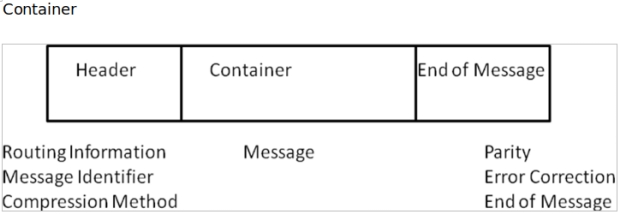
Figure 1 Message Encapsulation for Network Transmission
Given unknown compression techniques, error correction methods, message structure, and splitting messages among different frequencies and routes, intercepting and understanding traffic on the alien network may be impossible.
Frank Drake and others proposed direct communications using simple messages among the stars. “Hello” messages are sequences of bit strings easily reformatted into images depicting the Solar System and humans. If alien probes established interstellar mesh networks, it is highly probable those networks ignore Drake-type messages.
Von Neumann probes could explain the Great Silence. If robots are spreading into every nook and cranny of the Galaxy, the efficiency of radio transmissions as the contact medium is open to doubt. The physical presence of a probe in a distant star system removes any doubts about the nature of the signal. An alien spaceship provides instantaneous interchanges rather than slow century long conversations. Information density as represented by the probe is considerably greater than a radio signal could provide. Aliens may wait for contact through probes rather than relying on energy-hungry beams subject to misunderstanding launched into the unknown.
Researchers hypothesize signals intended for solar gravitational lens receivers could serve as technosignatures of advanced alien civilizations. Figure 2 diagrams a link between a transmitter in orbit about an alien star and a receiver within the Solar System.
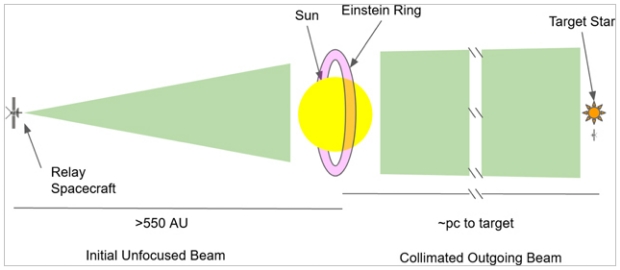
Figure 2 Architecture of a communications network based on an Einstein Ring [8].
In addition to detecting stray communications from distant transmitters, other detection methods are possible. A possible technosignature is light reflected from a station-keeping light sail. Assuming the communications node uses a light sail to maintain the system’s position, the sail reflects the Sun’s light back into the Solar System. A “star” whose spectrum suspiciously matches that of the Sun could point to the existence of an alien communications node.
Another technosignature possibility is an area of space which is slightly warmer than expected. This could be a clue that something is trying to hide by spreading its waste heat into a low temperature, innocuous blob.
If an alien probe is located, we could message the robot. “Active ” SETI, where humans transmit to aliens, rather than listen for alien communications, has roused protests from those who worry aliens are hostile. Communicating with alien nodes within the Solar System does not provide aliens with information which they do not already possess and avoids the concerns of active SETI opponents.
Researchers avoid the issue of identifying a signal by content. An alien relay using gravitational lensing is effectively motionless in relation to the Sun. Monochromatic signals should present Doppler shifts resulting from the Earth’s orbit and rotation assuming terrestrial based sensors.
Kerby and Wright generated criteria for a long-duration node using gravitational lensing [8]:
1. Close or moderately-distanced companion stars impart huge delta-v costs on a relay spacecraft, and thus close binary or multiple-star systems should be avoided.
2. The presence of gas giant planets either limits the maximum gain total of the stellar relay (depending on the reflex semimajor axis imparted on the host star) or imparts a delta-v cost of a few m s−1 per year to maintain alignment.
3. A more massive host star requires proportionally higher delta-v costs to resist its inward gravity.
4. A host star that is rapidly rotating will be deformed away from a spherical shape, resulting in a lens that does not have an exact focal point from which to transmit, resulting in significantly lowered gains.
The search for alien communications nodes orbiting nearby stars has already begun,
Table 1. Nearest network node: location priority list (top 10)
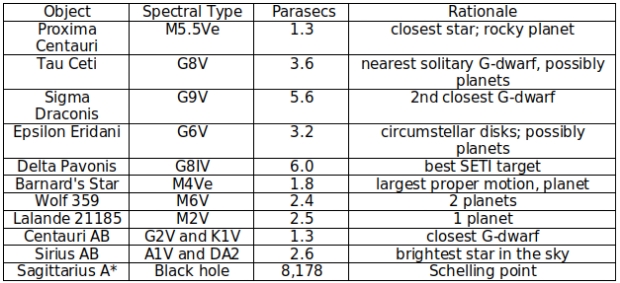
Note: In game theory, a Schelling point is a choice made without communication among the involved parties. Sagittarius A* may be chosen as a communications hub by aliens simply because it is such a visible feature located in the center of the Galaxy.
M. Gillon and other researchers examined Wolf 359 and TRAPPIST–1 for evidence of communications nodes in the vicinity of those stars.[5] No evidence of alien communications nodes was uncovered although there are any number of possible explanations for failure. The search continues and, contingent on funding, will expand to between ten and twenty stars.
For six months, a team led by G.W. Marcy searched for continuous and short period laser emissions from Proxima and Alpha Centuri. [6] Search equipment can detect power levels as low as one hundred Watts. No artificial laser light was observed in frequencies between 380 to 950 nanometers.
From the paper:
The intended recipient of the transmission is located at an unknown location near Proxima Centauri, leaving uncertain the most likely location of the local transmitter. Thus, during a year of observations, a transmitter located near the SGL focus line could appear within a region of roughly 400 arcsec from the coordinates given above. Parallax and aberration can be predicted for any instant, but the unknown location of the receiver near Proxima Centauri leaves the SGL location unknown within roughly 60 arcsec. We search within the full 400 arcsec domain for both sub-second pulses and long-lived emission of monochromatic sources. Our total field of view of 2.2 x 2.2 deg easily includes that 400 arcsec domain. Exploring the relatively large area around the anti-solar position of Proxima Cen expands the survey to include emitters located off-center that target only a fraction of the focal ring surrounding the Sun.
Two telescopes were used in the search. Candidate detections in the first were checked against exposures taken in the second telescope. No correlations were found.
Finally, a team used the Green Bank Telescope (GBT) and Breakthrough Listen (BL) backend to listen in the L and S bands for nodes using the Sun as for gravitational focusing [7]. The search covered possible nodes for Alpha Centauri AB system and HD 13908. This search was also unsuccessful although the work was regarded as proof-of-concept.
Searching for nodes in an interstellar network with a terminus within the Solar System has just begun. Earth based sensors can make relatively low-cost searches for Lurkers. Even if the probability of success is low, the enormous rewards of success merit the investment.
References
1. M. Gillon, A Novel SETI Strategy Targeting the Solar Focal Regions of the Most Nearby Stars, Acta Astronautica 94, 629 (2014)
2. M. Hippke, Interstellar Communications I Network, Overview and Assumptions, arXiv 1912.02616v2 (2019)
3. M. Hippke, Interstellar Communications II Deep Space Nodes with Gravitational Lensing, arXiv 2009.01866v1 (2020)
4. M. Hippke, Interstellar Communications III Locating Deep Space Nodes, arXiv 2104.09564v1 (2020)
5. M. Gillon, A. Burdanov, and J.T. Wright, Search for an Alien Communication from the Solar System to a Neighbor Star, arXiv 2111.05334 (2021)
6. G.W. Marcy, S.K.Tellis, and E.H. Wishnow, Laser Communications with Proxima Centauri using the Solar Gravitational Lens, Monthly Notices of the Royal Astronomical Society, 509-3, 3798-3814, https://arxiv.org/ftp/arxiv/papers/2110/2110.10247.pdf, (2022)
7. Nick Tusay, et al, A Search for Radio Technosignatures at the Solar Gravitational Lens Targeting Alpha Centauri, arXiv 2206.14807v1 (2022)
8. Stephen Kerby and Jason T. Wright, Stellar Gravitational Lens Engineering for Interstellar Communication and Artifact SETI, The American Astronomical Society, 2021 November 19, https://iopscience.iop.org/article/10.3847/1538-3881/ac2820


